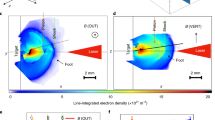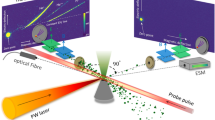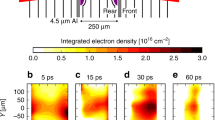Abstract
Astrophysical collisionless shocks are among the most powerful particle accelerators in the Universe. Generated by violent interactions of supersonic plasma flows with the interstellar medium, supernova remnant shocks are observed to amplify magnetic fields1 and accelerate electrons and protons to highly relativistic speeds2,3,4. In the well-established model of diffusive shock acceleration5, relativistic particles are accelerated by repeated shock crossings. However, this requires a separate mechanism that pre-accelerates particles to enable shock crossing. This is known as the ‘injection problem’, which is particularly relevant for electrons, and remains one of the most important puzzles in shock acceleration6. In most astrophysical shocks, the details of the shock structure cannot be directly resolved, making it challenging to identify the injection mechanism. Here we report results from laser-driven plasma flow experiments, and related simulations, that probe the formation of turbulent collisionless shocks in conditions relevant to young supernova remnants. We show that electrons can be effectively accelerated in a first-order Fermi process by small-scale turbulence produced within the shock transition to relativistic non-thermal energies, helping overcome the injection problem. Our observations provide new insight into electron injection at shocks and open the way for controlled laboratory studies of the physics underlying cosmic accelerators.
This is a preview of subscription content, access via your institution
Access options
Access Nature and 54 other Nature Portfolio journals
Get Nature+, our best-value online-access subscription
$29.99 / 30 days
cancel any time
Subscribe to this journal
Receive 12 print issues and online access
$209.00 per year
only $17.42 per issue
Buy this article
- Purchase on Springer Link
- Instant access to full article PDF
Prices may be subject to local taxes which are calculated during checkout




Similar content being viewed by others
References
Völk, H. J., Berezhko, E. G. & Ksenofontov, L. T. Magnetic field amplification in tycho and other shell-type supernova remnants. Astron. Astrophys. 433, 229–240 (2005).
Koyama, K. et al. Evidence for shock acceleration of high-energy electrons in the supernova remnant SN1006. Nature 378, 255–258 (1995).
Aharonian, F. A. et al. High-energy particle acceleration in the shell of a supernova remnant. Nature 432, 75–77 (2004).
Ackermann, M. et al. Detection of the characteristic pion-decay signature in supernova remnants. Science 339, 807–811 (2013).
Blandford, R. & Eichler, D. Particle acceleration at astrophysical shocks: a theory of cosmic ray origin. Phys. Rep. 154, 1–75 (1987).
Treumann, R. A. Fundamentals of collisionless shocks for astrophysical application, 1. non-relativistic shocks. Astron. Astrophys. Rev. 17, 409–535 (2009).
Sagdeev, R. Z. Cooperative phenomena and shock waves in collisionless plasmas. Rev. Plasma Phys. 4, 23–91 (1966).
Oka, M. et al. Electron scattering by high-frequency whistler waves at Earth’s bow shock. Astrophys. J. 842, L11 (2017).
Hoshino, M. & Shimada, N. Nonthermal electrons at high mach number shocks: electron shock surfing acceleration. Astrophys. J. 572, 880–887 (2002).
Spitkovsky, A. Particle acceleration in relativistic collisionless shocks: Fermi process at last? Astrophys. J. 682, L5–L8 (2008).
Kato, T. N. & Takabe, H. Nonrelativistic collisionless shocks in unmagnetized electron-ion plasmas. Astrophys. J. 681, L93–L96 (2008).
Matsumoto, Y., Amano, T., Kato, T. N. & Hoshino, M. Stochastic electron acceleration during spontaneous turbulent reconnection in a strong shock wave. Science 347, 974–978 (2015).
Kugland, N. L. et al. Self-organized electromagnetic field structures in laser-produced counter-streaming plasmas. Nat. Phys. 8, 809–812 (2012).
Ross, J. S. et al. Characterizing counter-streaming interpenetrating plasmas relevant to astrophysical collisionless shocks. Phys. Plasmas 19, 056501 (2012).
Fox, W. et al. Filamentation instability of counterstreaming laser-driven plasmas. Phys. Rev. Lett. 111, 225002 (2013).
Huntington, C. M. et al. Observation of magnetic field generation via the Weibel instability in interpenetrating plasma flows. Nat. Phys. 11, 173–176 (2015).
Ross, J. S. et al. Transition from collisional to collisionless regimes in interpenetrating plasma flows on the national ignition facility. Phys. Rev. Lett. 118, 185003 (2017).
Schaeffer, D. B. et al. Generation and evolution of high-mach-number laser-driven magnetized collisionless shocks in the laboratory. Phys. Rev. Lett. 119, 025001 (2017).
Li, C. K. et al. Collisionless shocks driven by supersonic plasma flows with self-generated magnetic fields. Phys. Rev. Lett. 123, 055002 (2019).
Rigby, A. et al. Electron acceleration by wave turbulence in a magnetized plasma. Nat. Phys. 14, 1745–2481 (2018).
Ryutov, D. D. et al. Basic scalings for collisionless-shock experiments in a plasma without pre-imposed magnetic field. Plasma Phys. Control. Fusion 54, 105021 (2012).
Takabe, H. et al. High-mach number collisionless shock and photo-ionized non-LTE plasma for laboratory astrophysics with intense lasers. Plasma Phys. Control. Fusion 50, 124057 (2008).
Tidman, D. A. & Krall, N. A. Shock Waves in Collisionless Plasmas (Wiley-Interscience, 1971).
Gurevich, A. V. et al. Self-similar motion of rarefied plasma. Sov. Phys. J. Exp. Theor. Phys. 22, 449–454 (1966).
Trubnikov, B. A. Particle interactions in a fully ionized plasma. Rev. Plasma Phys. 1, 105 (1965).
Weibel, E. S. Spontaneously growing transverse waves in a plasma due to an anisotropic velocity distribution. Phys. Rev. Lett. 2, 83–84 (1959).
Fried, B. D. Mechanism for instability of transverse plasma waves. Phys. Fluids 2, 337–337 (1959).
Medvedev, M. V., Fiore, M., Fonseca, R. A., Silva, L. O. & Mori, W. B. Long-time evolution of magnetic fields in relativistic gamma-ray burst shocks. Astrophys. J. 618, L75–L78 (2004).
Ruyer, C. & Fiuza, F. Disruption of current filaments and isotropization of the magnetic field in counterstreaming plasmas. Phys. Rev. Lett. 120, 245002 (2018).
Hillas, A. M. The origin of ultra-high-energy cosmic rays. Annu. Rev. Astron. Astrophys. 22, 425–444 (1984).
Froula, D. H., Glenzer, S. H., Luhmann, N. C. & Sheffield, J. (eds) Plasma Scattering of Electromagnetic Radiation 2nd edn (Academic Press, 2011).
Mariscal, D. et al. Calibration of proton dispersion for the NIF electron positron proton spectrometer (NEPPS) for short-pulse laser experiments on the NIF ARC. Rev. Sci. Instrum. 89, 10I145 (2018).
Bonnet, T. et al. Response functions of imaging plates to photons, electrons and 4He particles. Rev. Sci. Instrum. 84, 103510 (2013).
Halverson, W. Bremsstrahlung photon emission rate from Maxwellian plasmas. Plasma Phys. 14, 601–604 (1972).
Marinak, M. M. et al. Three-dimensional hydra simulations of National Ignition Facility targets. Phys. Plasmas 8, 2275–2280 (2001).
Fonseca, R. A et al. OSIRIS: A Three-Dimensional, Fully Relativistic Particle in Cell Code for Modeling Plasma Based Accelerators (Springer, 2002).
Fonseca, R. A. et al. One-to-one direct modeling of experiments and astrophysical scenarios: pushing the envelope on kinetic plasma simulations. Plasma Phys. Control. Fusion 50, 124034 (2008).
Acknowledgements
We thank M. Hohenberger and G. Fiksel for their assistance in the analysis of FFLEX and NEPPS data, respectively. This work was supported by the US Department of Energy SLAC contract no. DE-AC02-76SF00515 and Lawrence Livermore National Laboratory contract no. DE-AC52-07NA27344, the US DOE Early Career Research Program under FWP 100331, the US DOE Office of Science, Fusion Energy Sciences under FWP 100182, the LLNL Laboratory Directed Research and Development Program grant 15-ERD-065, and the Engineering and Physical Sciences Research Council of the United Kingdom (grant nos. EP/M022331/1 and EP/N014472/1). We also acknowledge the OSIRIS Consortium, consisting of UCLA and IST (Portugal) for the use of the OSIRIS 4.0 framework and the visXD framework. Simulations were run on Mira and Theta (ALCF) through ALCC awards and on Vulcan and Quartz (LLNL) through grand challenge awards.
Author information
Authors and Affiliations
Contributions
F.F. and H.-S.P. conceived and led this project. The experiments were designed and carried out by G.F.S., H.G.R., H.-S.P. and F.F. The data were analysed by G.F.S., H.G.R., C.B., B.B.P. and F.F. Numerical simulations were performed by A.G., F.F., D.P.H. and S.W. Additional theoretical support was provided by D.D.R., W.R., A.S. and G.G. The paper was written by F.F. with contributions from all the authors.
Corresponding author
Ethics declarations
Competing interests
The authors declare no competing interests.
Additional information
Publisher’s note Springer Nature remains neutral with regard to jurisdictional claims in published maps and institutional affiliations.
Extended data
Extended Data Fig. 1 X-ray self emission from the plasma.
Lineouts of the X-ray signal along the mid-plane between the two targets for a) single flow and b) double flow experiments at 15 ns from the laser irradiation. The gated X-ray detector uses Vanadium (V, left) and Nickel (Ni, right) filters. The measured signal ratio between double flow and single flow experiments is ~100−200, consistent with predictions based on the plasma density and temperature from Thomson scattering measurements.
Supplementary information
Supplementary Information
Supplementary Figs. 1–4, discussion, and Tables 1 and 2.
Source data
Source Data Fig. 2
Numerical data used to generate the graphs in Fig. 2.
Source Data Fig. 3
Numerical data used to generate the graphs in Fig. 3c,d.
Source Data Fig. 4
Numerical data used to generate the graphs in the Fig. 4a,b,c(inset),4d.
Rights and permissions
About this article
Cite this article
Fiuza, F., Swadling, G.F., Grassi, A. et al. Electron acceleration in laboratory-produced turbulent collisionless shocks. Nat. Phys. 16, 916–920 (2020). https://doi.org/10.1038/s41567-020-0919-4
Received:
Accepted:
Published:
Issue Date:
DOI: https://doi.org/10.1038/s41567-020-0919-4
This article is cited by
-
Turbulent magnetic reconnection generated by intense lasers
Nature Physics (2023)
-
Self-organization of photoionized plasmas via kinetic instabilities
Reviews of Modern Plasma Physics (2023)
-
Downstream high-speed plasma jet generation as a direct consequence of shock reformation
Nature Communications (2022)
-
Electron energization dynamics in interaction of self-generated magnetic vortices in upstream of collisionless electron/ion shocks
Scientific Reports (2022)
-
Laboratory evidence for proton energization by collisionless shock surfing
Nature Physics (2021)



